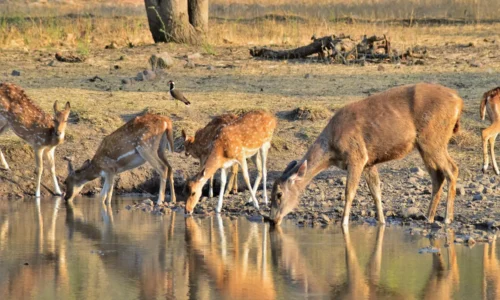Going on a safari is an exciting adventure that offers a unique opportunity to witness wildlife in its natural habitat. Whether traveling to Africa, India, or any other safari destination, the right clothing can make a huge difference in your comfort, safety, and overall experience. Safari environments, which often feature hot days, cool nights, and dusty conditions, require specific attire to ensure you are prepared for all aspects of the journey.
In this blog, we’ll cover the best clothing choices for a safari to help you stay comfortable, blend in with your surroundings, and stay safe in the wild.
1. Choose Lightweight and Breathable Fabrics
Safari locations, especially in Africa and India, are hot during the day, with temperatures often exceeding 80°F (27°C). To stay comfortable, it’s essential to wear lightweight, breathable fabrics that allow your skin to breathe while keeping you cool.
Cotton and Linen: These fabrics are light, breathable, and natural, making them perfect for hot weather. They absorb sweat and allow air to flow through, helping you stay cool.
Moisture-wicking Fabrics: Look for clothing made from synthetic materials like polyester and nylon, which wick away sweat from your body, keeping you dry. These fabrics are often used in outdoor gear and are great for staying comfortable during long hours on safari.
Avoid Heavy Fabrics: While denim and heavy wool might seem like sturdy options, they’re best avoided as they can trap heat and make you feel hot and uncomfortable.
2. Stick to Neutral or Earthy Colors
When going on safari, blending in with your environment is important for your comfort and safety. Bright colors, such as neon and white, stand out and can attract unwanted attention from wildlife. Additionally, white clothes can become easily dirty in a dusty environment.
Beige, Brown, Olive Green, and Khaki: These neutral and earthy tones are the ideal choice for safari clothing as they help you blend in with the natural surroundings. They are also practical because they don’t show dirt as easily, and they offer a more camouflage-like appearance.
Avoid Bright Colors: Bright reds, oranges, and yellows can make you more visible to animals, which could potentially disturb their natural behavior. Stick with subtle hues that will keep you more inconspicuous.
3. Protect Yourself from the Sun and Insects
While on safari, you’ll likely be exposed to long hours of direct sunlight, so protecting yourself from harmful UV rays is essential. In addition, safari destinations, especially in Africa, are home to a variety of insects, including mosquitoes, which can carry diseases like malaria.
Long-Sleeve Shirts and Long Pants: Despite the heat, wearing long-sleeve shirts and long pants can help protect your skin from the sun, scratches from bushes, and bug bites. Lightweight, breathable fabrics like cotton or nylon are great for these types of clothing, as they provide sun protection while keeping you cool.
Wide-brimmed Hat: A hat with a wide brim will shield your face, neck, and ears from the sun, reducing your risk of sunburn. Make sure it is made of a breathable material like cotton or straw.
Sunscreen: While not clothing, sunscreen is a must-have on safari. Apply sunscreen with a high SPF (at least 30) to all exposed skin, including your face, neck, and hands, and reapply regularly throughout the day.
Insect Repellent: To prevent insect bites, especially from mosquitoes, apply a good insect repellent to exposed skin. In areas where malaria is prevalent, make sure to choose a repellent that contains DEET or other recommended ingredients.
4. Comfortable and Sturdy Footwear
When going on a safari, you will likely do a lot of walking and spend time traveling over uneven and sometimes rugged terrain. Wearing comfortable, durable footwear is key to ensuring you’re able to explore without discomfort or injury.
Sturdy Hiking Boots or Shoes: Choose shoes with good support and traction, such as hiking boots or sturdy walking shoes. Opt for ankle-high boots that will protect your feet and ankles from rocks, thorny plants, and insects.
Breathable Socks: Make sure to wear moisture-wicking socks made of materials like merino wool or synthetic fibers to prevent blisters and keep your feet dry.
Flip-Flops for Relaxing: While you’ll need sturdy footwear for activities, you can bring flip-flops or sandals for relaxing at the lodge or campsite during your downtime.
5. Layering for Changing Temperatures
Safari climates can vary greatly, with hot days and chilly mornings and evenings. It’s important to bring layers so you can adapt to changing temperatures throughout the day.
Light Jacket or Fleece: For early morning and evening game drives, it can be quite cool. A light jacket, fleece, or sweater will keep you warm. Fleece is an excellent choice because it is lightweight, warm, and quick-drying.
Zip-off Pants: Consider wearing pants with zip-off legs that can convert into shorts. This way, you can easily adjust to the temperature changes by removing or adding the legs as needed.
Light Scarf or Buff: A scarf or buff can be a useful addition for the mornings when there’s a chill in the air or to protect your neck from the sun during the day.
6. Essential Accessories for Comfort and Safety
There are a few additional accessories that will make your safari experience more enjoyable and safe.
Binoculars: Essential for wildlife viewing, binoculars will help you get a closer look at animals from a safe distance.
Camera with a Telephoto Lens: A camera is a must for capturing the incredible wildlife you encounter. A telephoto lens will allow you to photograph animals from afar without disturbing them.
Sunglasses: Protect your eyes from the glare of the sun with high-quality UV-blocking sunglasses.
Daypack or Small Backpack: A small, lightweight backpack will allow you to carry essentials like water, snacks, sunscreen, camera gear, and a first aid kit.
7. Avoid Packing Excess Clothing
Safari outfits don’t need to be complicated. It’s best to pack versatile clothing that can be mixed and matched for comfort and practicality. You won’t need a lot of clothes—just a few key items that are easy to wear and care for.
Plan for Comfort and Practicality: Focus on lightweight, breathable, and durable clothing that is easy to move in. It’s better to pack fewer items that you can rotate throughout the trip.
Conclusion: Dressing for Safari Success
Dressing appropriately for a safari is about ensuring that you stay comfortable, protected, and safe throughout your adventure. By choosing lightweight, breathable fabrics, wearing neutral colors, and layering for different temperatures, you’ll be able to make the most of your safari experience without the distraction of discomfort. With the right clothing, you’ll be able to focus on what matters most—observing the wildlife and immersing yourself in the beauty of nature. So, pack wisely, and get ready for the adventure of a lifetime!




